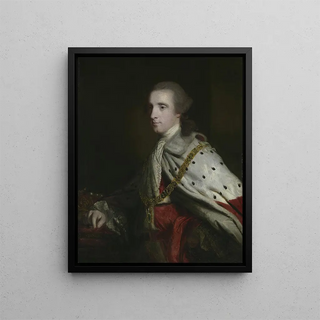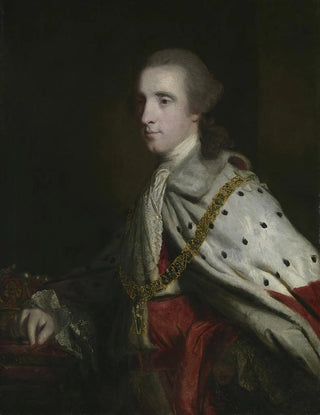Art print | The 4th Duke of Queensberry Old Q as Earl of March - Sir Joshua Reynolds


View from behind

Frame (optional)
Reproduction of The 4th Duke of Queensberry, also known as Old Q, by Sir Joshua Reynolds – Captivating introduction
The portrait of the 4th Duke of Queensberry, also known as Old Q, created by Sir Joshua Reynolds, is an iconic work that embodies the elegance and refinement of 18th-century British painting. This masterful creation depicts not only a nobleman of great stature but also serves as a testament to the art of portraiture at a time when social and political identity held paramount importance. By contemplating this piece, the viewer is immediately transported into a universe where nobility and art intersect, revealing the subtleties of the duke's personality through meticulous details and harmonious composition.
Style and uniqueness of the work
Reynolds' style is distinguished by his ability to capture light and movement, giving his subjects an almost lifelike presence. In the portrait of the Duke of Queensberry, there is an exceptional mastery of color and texture, which brings to life the rich fabrics of the costume and the delicacy of facial features. The duke's gaze, both penetrating and serene, seems to engage in a silent dialogue with the observer, revealing rare psychological depth. The composition is carefully balanced, with each element arranged to direct the viewer's attention to the duke's face, the true focal point of the work. This portrait is not merely a simple representation; it is a celebration of individuality, where every detail—from the choice of colors to the posture—contributes to creating a memorable image.
The artist and his influence
Sir Joshua Reynolds, an emblematic figure of English painting, made his mark on his era with his innovative approach to portraiture. As the first president of the Royal Academy, he not only shaped the art of his time but also influenced generations of artists to come. His technique, which combines classicism with romantic sensitivity, paved the way for a new way of perceiving portraiture. Reynolds was able to capture not only the external appearance of his subjects but also their essence, character, and social status. His influence is evident in the works of many artists, who sought to imitate his style or draw inspiration from it to explore new artistic horizons.

Matte finish

View from behind

Frame (optional)
Reproduction of The 4th Duke of Queensberry, also known as Old Q, by Sir Joshua Reynolds – Captivating introduction
The portrait of the 4th Duke of Queensberry, also known as Old Q, created by Sir Joshua Reynolds, is an iconic work that embodies the elegance and refinement of 18th-century British painting. This masterful creation depicts not only a nobleman of great stature but also serves as a testament to the art of portraiture at a time when social and political identity held paramount importance. By contemplating this piece, the viewer is immediately transported into a universe where nobility and art intersect, revealing the subtleties of the duke's personality through meticulous details and harmonious composition.
Style and uniqueness of the work
Reynolds' style is distinguished by his ability to capture light and movement, giving his subjects an almost lifelike presence. In the portrait of the Duke of Queensberry, there is an exceptional mastery of color and texture, which brings to life the rich fabrics of the costume and the delicacy of facial features. The duke's gaze, both penetrating and serene, seems to engage in a silent dialogue with the observer, revealing rare psychological depth. The composition is carefully balanced, with each element arranged to direct the viewer's attention to the duke's face, the true focal point of the work. This portrait is not merely a simple representation; it is a celebration of individuality, where every detail—from the choice of colors to the posture—contributes to creating a memorable image.
The artist and his influence
Sir Joshua Reynolds, an emblematic figure of English painting, made his mark on his era with his innovative approach to portraiture. As the first president of the Royal Academy, he not only shaped the art of his time but also influenced generations of artists to come. His technique, which combines classicism with romantic sensitivity, paved the way for a new way of perceiving portraiture. Reynolds was able to capture not only the external appearance of his subjects but also their essence, character, and social status. His influence is evident in the works of many artists, who sought to imitate his style or draw inspiration from it to explore new artistic horizons.






